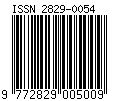PENDEKATAN SPASIAL EKOLOGIS UNTUK PENGELOLAAN DAERAH ALIRAN SUNGAI (DAS) BERKELANJUTAN BERBASIS PENGENDALIAN EROSI (STUDI KASUS DI SUB DAS NGRANCAH, KABUPATEN KULON PROGO)
Kata Kunci:
Spatial Ecology, Spatial Harmonism, erosion, RUSLE, QSBAbstrak
Sustainable development basically lies in the achievement of harmonisation between economic, ecological and social purposes. One form of sustainable development fromthe perspective of ecological dimension is the existence of spatial harmonism. Spatial harmonism means that in every development area have to allocate conservation area that has been identified in the form of forest area or area which serves as a forest (rural forest). Both in forest law and spatial law consider the existence of forets area at least 30 % of the watershed area.The research was conducted at Ngrancah Sub Watershed. Ngrancah Sub watershed is one part of Serang Watershed. According to Forestry minister decree Nr. 328 year 2009, Serang watershed is one of 108 critical watersheds and need to be given priority handling. The aims of this research are : (1) to investigate soil erosion, soil erosion rates, and soil erosion index ;(2) to analyze spatial ecology harmonism based on erosion control to optimize conservation area. Ngrancah Sub Watershed is the catcment area of Sermo Dam. The area of Ngrancah Sub Watershed is almost 2150 hectares. The area is mostly critical showed by the high rate of erosion. The high rate of erosion indicates that Ngrancah Sub Watershed needs to be manage and handled properly to reduce land degradation. Erosion is predicted using RUSLE Method (RUSLE Equation EA = Ri .K.L.S.C.P) and water balance (aridity index) based on its meteorogical function is calculated using Tornthwaite-Mather method. Isohyet methode is used to calculated rainfall while erodibility factor is calculated using Willem Formula (1995). According to Minimum Legible Area (Vink, 1975), research area could be classified into 80 spatial/ecological units. Slope observation and soil conservation practices is done in each spatial/ecological unit as well as soil samples also taken in each spayial/ecological unit. Linear program with QSB+ Software is conducted to analyse the data.The result of the research showed that the erosion rates varies from the lowest rate of 3,83 ton/ha/year to the highest rate of 494,91 ton/ha/year. About 39,98 % of research area is classified as moderate erosion rate area and about 38,39% of the area as high into very high erosion rate area. Based on Erosion Indeks, about 16,22% of the area is classified as the moderate Erosion Indeks and 73,30% of the area as high into very high Erosion Indeks. Spatial Ecology approach for sustainable watershed management by QSB+ program on the effort of erosion controll showed that to achieve spatial ecology harmonism is needed 87,48 % conservation area (area that identified as forest function) from the total area of Ngrancah Sub Watershed. Rural forest development (or agroforestry) involving local community is recommended to meet spatial ecology harmonism considering existing condition of Ngrancah Sub Watershed that only 2 % of forest area in Ngrancah Sub Watershed.
Key Words : Spatial Ecology, Spatial Harmonism, erosion, RUSLE , QSB+










